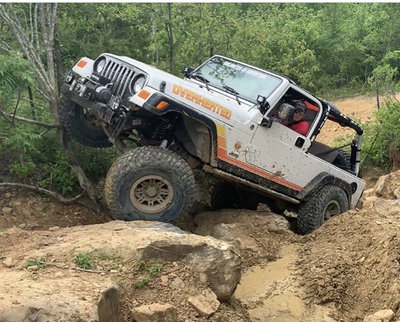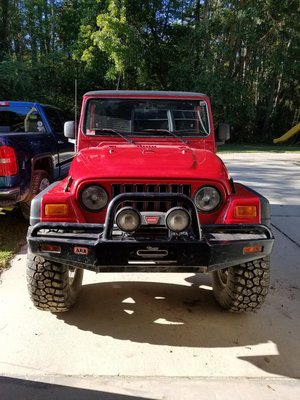I posted this on an LS swapper Wrangler FB group and got all kinds of answers. Most revolve around air flow, and got one suggestion I hadn't thought of.
5.3 4l60, 4.88s and 35s in stock appearing LJ. Superior radiator, fan, shroud combo with trans cooler. I have 1,250 miles on swap so far. Prior to last weekend, longest drive was 35 miles with 10 miles interstate. Around town and country roads temp runs 180-195. On the interstate after running 70 for 10 minutes or so, it'll creep up to 210, but as soon as back on country road at 55 it drops back to 195. Last Saturday we did 335 miles pretty much non stop. 60 mph 2 lane, mountain roads, some light trails, and 60 mph home. Temp was 195 for 100 miles to the mountains.. As soon as we hit the mountain climbs it went to 210 and creeped to 230 on one steep climb going slow in traffic. Rest of the day it stayed around 210, and all the way home at 210 except when we slowed down through small towns it would drop back to 195-200.
I know 210 is fine and what it would run in its stock vehicle, but its never stayed at 210 before and I definitely didn't like seeing 230. I have 2 theories.
1)Airflow at speed. I have an arb bumper, winch, stock fog lights. Would too much air be deflected at speed, or is it possible that the air under the hood doesn't have anywhere to go so not letting enough through radiator. I have some louvers I bought for vaporlocking on the 4.0 but never installed. Hood is damaged now so don't feel too bad about cutting it up.
2) Trans heating up and reducing efficiency of radiator. I could put a remote cooler with fan on it, but I don't necessarily like the electric fan under tub with water/mud. If I went this route, would you run it through both coolers or just the remote?
I don't feel like it's an issue with the radiator itself or the fan. At speed is the issue where fan capacity should be irrelevant.
Anybody experienced anything similar? What would you do?
5.3 4l60, 4.88s and 35s in stock appearing LJ. Superior radiator, fan, shroud combo with trans cooler. I have 1,250 miles on swap so far. Prior to last weekend, longest drive was 35 miles with 10 miles interstate. Around town and country roads temp runs 180-195. On the interstate after running 70 for 10 minutes or so, it'll creep up to 210, but as soon as back on country road at 55 it drops back to 195. Last Saturday we did 335 miles pretty much non stop. 60 mph 2 lane, mountain roads, some light trails, and 60 mph home. Temp was 195 for 100 miles to the mountains.. As soon as we hit the mountain climbs it went to 210 and creeped to 230 on one steep climb going slow in traffic. Rest of the day it stayed around 210, and all the way home at 210 except when we slowed down through small towns it would drop back to 195-200.
I know 210 is fine and what it would run in its stock vehicle, but its never stayed at 210 before and I definitely didn't like seeing 230. I have 2 theories.
1)Airflow at speed. I have an arb bumper, winch, stock fog lights. Would too much air be deflected at speed, or is it possible that the air under the hood doesn't have anywhere to go so not letting enough through radiator. I have some louvers I bought for vaporlocking on the 4.0 but never installed. Hood is damaged now so don't feel too bad about cutting it up.
2) Trans heating up and reducing efficiency of radiator. I could put a remote cooler with fan on it, but I don't necessarily like the electric fan under tub with water/mud. If I went this route, would you run it through both coolers or just the remote?
I don't feel like it's an issue with the radiator itself or the fan. At speed is the issue where fan capacity should be irrelevant.
Anybody experienced anything similar? What would you do?


